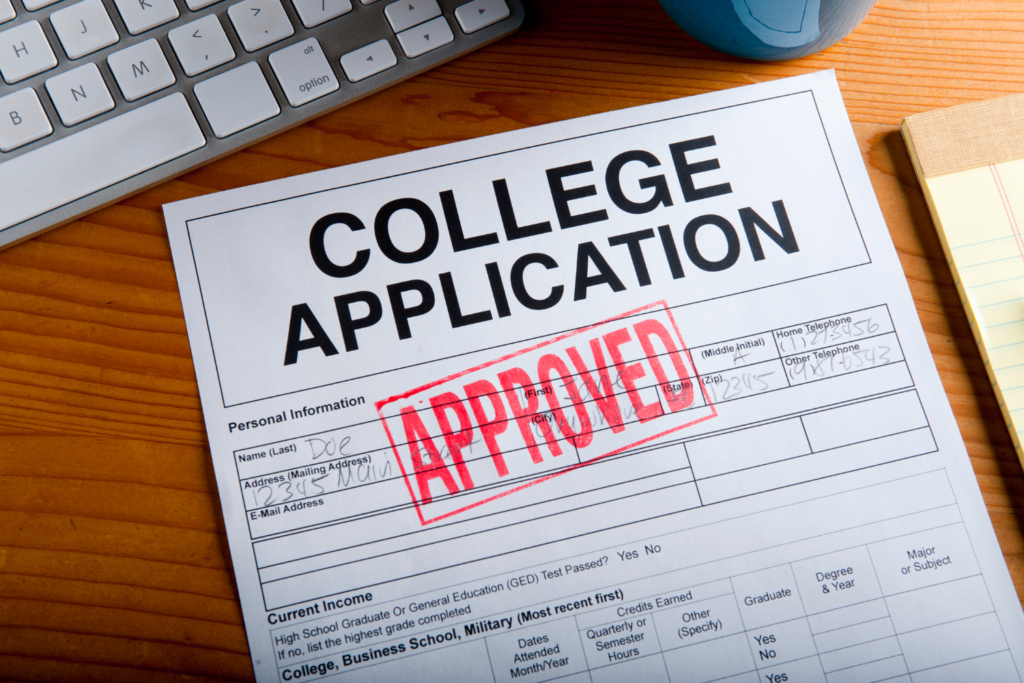When applying to colleges, the list of items needed can get confusing, and filling out a college application can become stressful. Here are basic application components.
In this post:
College Application Checklist
While the list of required application materials varies according to each school, there are some basic staples that are a part of most college applications. Some schools may say that certain things have to be included and others are optional but encouraged; other schools may stipulate that all of the following pieces be included in a student’s file.
- Fill out the FAFSA form as soon as possible after October 1st.
- Take the SAT or ACT and send your scores to colleges.
- Research colleges and narrow down your list of schools.
- Visit colleges if possible.
- Apply to colleges through their individual websites or Common App.
- Complete any supplemental essays or short answer questions.
- Send in your final transcripts.
- Wait for admissions decisions from colleges! Be sure to check your email and portal accounts frequently.
- If you are waitlisted at a college, you may send in additional materials to try to improve your chances of getting off the waitlist.
- Once you have made your decision, send in your deposit to reserve your spot at college!
- Attend orientation and get excited for the next chapter of your life!
The Application Form and Application Supplements
Contact a school’s Admissions Office, or look at the college or university’s website, to see what sort of application is used. Some schools may prefer the Common Application, other schools may have a separate, school-specific application. For schools that use the Common Application or some other standard, generalized application form, it is important to check if there is also an application supplement that schools like students to fill out. Usually, these supplemental forms have questions like, “Why are you applying to (name of school)?”
Academic Information for the Application
Just about every school will request that applicants submit a high school transcript, GED transcript, and/or college transcript, depending on a student’s level of education. For high school students, the guidance counselors are usually the ones who handle sending high school transcripts out to colleges.
Standardized test scores are not required by every school, but those that do require students to take the SAT or ACT often look at the highest combined score. This is why it is important to have all scores sent to a school; if a student takes the SAT twice and scores higher on the Critical Reading section than the Math section the first time around, but does the opposite the second time around, the school will take the highest Critical Reading and the highest Math score and add those up, creating the highest possible composite score. The College Board’s website is the place to go to send out scores to a particular school.
Personal Information to Send to Schools
Though not every school requires an essay and/or letters of recommendation, just about all of them will strongly encourage students to submit this information to supplement the application. College admissions officers especially like to read essays and letters if they are on the fence about admitting a student; a great letter from a teacher or a phenomenal personal essay may just be what earns a student a spot in the “Accept” pile. Students should research each school they plan to apply to in order to find out 1) whether an essay and recommendations are required, and 2) how many are needed to complete the application.
Other Application Materials
A resume or list of extracurricular activities, samples of work (for example, artwork for an art school, a digital playlist for a music school), and anything else that can make a student stand out among the piles of files (in a positive way, of course) can go a long way with an admissions committee. Taking the time to add extra components to the application shows conscientious effort on the student’s part to create the best possible impression. This is also impressive to the college because it shows that a potential student is genuinely interested in that particular college.
College Application FAQs
Here are some frequently asked questions about college applications.
When should I take the SAT or ACT?
You should take the SAT or ACT as soon as possible, so that you can send your scores to colleges. Most students take the tests during their junior year.
What is the FAFSA form?
The FAFSA form is a financial aid form that you need to fill out in order to receive financial aid from colleges. The form becomes available on October 1st each year.
How many colleges should I apply to?
You should apply to around 8-10 colleges. This way, you will have a few safety schools, a few reach schools, and a few schools in the middle.
What if I don’t get into my first choice college?
It’s okay if you don’t get into your first choice college! You will likely be just as happy at your second or third choice school. The most important thing is that you find a college where you will be happy and successful.
What is orientation?
Orientation is a program that all new college students are required to attend. It usually takes place a few weeks before classes start, and it’s a great way to meet other new students and learn more about your college.
Conclusion
Knowing the basics of submitting a college application can make the whole process of applying less stressful, and helps students remember the necessary components for each individual school.
Applying to college can seem daunting, but if you break it down into steps, it’s not so bad. Use this checklist to make sure you don’t forget anything during the process. And remember, even if things don’t go exactly as planned, you will end up at a college where you will be happy and successful.





